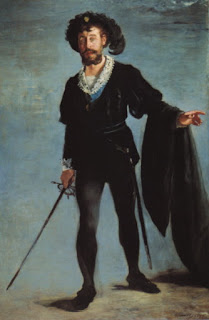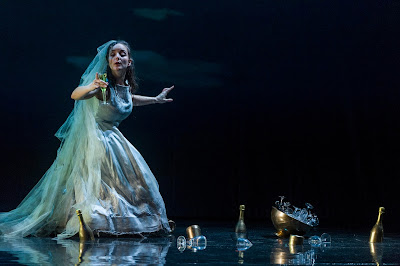 |
| Ambroise Thomas: Hamlet - Opera2Day - Quirijn de Lang, Martijn Sanders, Joop Keesmat (Photo Ben van Duin) |
Reviewed by Robert Hugill on Jan 30 2018 Star rating:
Ambroise Thomas' Shakespearean opera stripped back to its highly expressive bones
 |
| Jean-Baptise Faure as Ambroise Thomas' Hamlet in 1877 by Edouard Manet |
The opera tends to be revived once per generation, giving the current lyric baritone a chance to sing the role but it is hardly repertoire stuff. The Hague-based Dutch company OPERA2DAY has decided to take the plunge and the company's director Serge van Veggel has come up with a remarkable re-invention of the piece, discovering something far more urgent and intense underneath the padding of Thomas' grand opera.
I caught up with OPERA2DAY's performance at the Koninklijke Schouwburg in the Hague on 30 January 2018. Conducted by Hernan Schvartzman, Serge van Veggel's production used designs by Herbert Janse and videos by Margo Onnes, lighting by Uri Rapaport and costumes by Mirjam Pater. The opera was performed in a version by Daniel Hamburger for the 16-piece New European Ensemble (artistic director Emlyn Stam) and sung by a cast of just twelve, Quirijn de Lang as Hamlet, Lucie Chartin as Ophélie, Martijn Sanders as Claudius, Martina Prins as Gertrude, plus Jan-Willem Schaafsma, Patrick Pranger, Joop Keesmaat, Yavuz Arman isleker, Georgi Sztojanov, Judith Pranger, Sonja Volten, and Adelaide Rouyer as an ensemble who provided both chorus and shared the smaller roles.
 |
| Lucie Chartin (Photo Ben van Duin) |
The opera was cut quite considerably, there was no ballet and other scenes were cut or trimmed. The character of Polonius (a minor one in this opera) was dropped entirely. The result was lithe, focussed and highly dramatic. Not Shakespeare, but something new. The opera exists in two versions, the original expansive grand opera ending with its lieto fine and a more concise tragic one, known as the Covent Garden ending though it is not known if this was used there. In fact, when Nellie Melba sang Ophélie at Covent Garden the evening would usually end after the mad scene. The ending used by Opera2Day was based on Thomas' tragic end but with the choral interjections from the original version.
The production was modern dress, with the main visual element being video. Scenically the opera was quite simple, and centred on the bier of the late King of Denmark. In fact, things started even before the curtain went up as a community chorus and local amateur brass band (the company works with a different group in each location where they are performing the opera), performed the music for Ophélie's funeral but this time adapted for the funeral of Hamlet senior, carrying his bier through the audience members assembled in the foyer. And then once in the theatre this flag-draped bier was at centre stage and that shape stayed there for most of the opera.
 |
| Ambroise Thomas: Hamlet - Opera2Day (Photo Ben van Duin) |
It helped that Quirijn de Lang was such an expressive and intensely dramatic performer. This was not one of those performances which prized beauty of tone above all else, though de Lang sang with a nice flexibility of line and suppleness, but he seemed to prize vivid intensity above all things and this was a Hamlet who we could hear, really suffered. His performance kept you involved from the moment he was on stage to the very end.
Lucie Chartin's Ophélie was a remarkably poised and intense creation, rather brittle at first but entirely comfortable in her coloratura, Lucie Chartin shone in the great showpiece of the mad scene. Again, like Quirijn de Lang she clearly prized expressiveness again simply canary fancying, and gave a remarkably disturbing portrait of the now mad young woman, slitting her wrists. But she did not omit one of the most important elements from the scene, charm; Thomas' music takes a very particular view (rather reductive, it could be argued) of Ophélie and we cannot make it otherwise. Lucie Chartin brought just the right elements of naive charm and wonder to the scene.
 |
| Quirijn de Lang, Martina Prins - Opera2Day (Photo Ben van Duin) |
The remaining singers were all admirably vivid and hard-working, cropping up in a variety of roles as well as creating the chorus, forming a strong backdrop for the protagonists. The scene with the players, with its remarkable saxophone solo in the orchestra, was very vividly mimed, and the short scene with the two grave-diggers (Patrick Pranger and Georgi Sztojanov), here stove-pipe hat Victorians, make a remarkably powerful impact. Jan-Willem Schaafsma sang Laerte, the opera's only major tenor part, not ideally relaxed in tone but with striking vividness.
The opera was played with discreet amplification Arne Bock. This added extra acoustic to the sound, and whilst both voices and instruments were heard with admirable naturalness, it seemed to rebalance them and from my seat in row 12 of the stalls, often favoured the instrument somewhat.
We were always going to lose something, playing Thomas' score with a 15-piece band with just five string players, but under Hernan Schvartzman's direction the remarkable thing was how much was preserved, and how the players made this new lithe version of the score work well.
The style of the performance seemed quite free, with the singers using the music with remarkable expressive freedom. A clue to the performance came from the instrumental contribution where the string portamentos were quite surprising; perfectly in keeping with the music, but a style which is rarely done nowadays. The company has quite an interest in period style, and the choice of Hamlet was partly inspired by the history of the Koninlijke Schouwburg which was an opera house the Theatre Francaise de la Haye until 1919, and where Hamlet was played regularly and the archive of scores and parts still survive. So performances by the company explore elements of how modern singers might relate to period vocal style. There was nothing self conscious about this, but you were aware of the freedom with which the performers felt able to treat the music and this was inspired by the freedom which we know from very early 20th century recordings.
This was the fourth time that I have heard Ambroise Thomas' Hamlet. I first came across it in 1980 at the Buxton Festival directed by Malcolm Fraser with Thomas Allen in the title role, and then in 1995 David McVicar produced it at Opera North with Anthony Michaels Moore, and in 2003 the opera re-appeared at Covent Garden for the first time since 1910 in Patrice Caurier and Moshe Leiser's production with Simon Keenlyside and Natalie Dessay.
 |
| Ambroise Thomas: Hamlet - Quirijn de Lang, Patrick Pranger, Georgi Sztojanov- Opera2Day (Photo Ben van Duin) |
I will be writing about this production further, for Opera Now magazine.
Elsewhere on this blog:
- Music for the Queen of Heaven - the Marian Consort in 21st and 20th century music - CD review
- Debut treehouse - intimate, innovative and engaging - concert review
- Classical music with a popular twist: I chat to Lithuanian composer Gediminas Gelgotas - interview
- Seeing the genre develop: Lully & Quinault's second tragédie en musique, Alceste - CD review
- Celebrating Estonian style - the distinctively stylish Estonian Voices - concert review
- 1768: A Retropective - Chiara Skerath, Katy Bircher, Ian Page, The Mozartists at the Wigmore Hall - concert review
- The Schuman's at Home - Julius Drake and Sophie Bevan at Temple Music - concert review
- Eavesdropping on David Pountney rehearsing Verdi's La forza del destino at Welsh National Opera - feature article
- Chants d'amour - Louise Alder and James Baillieu in Mozart, Bizet, Strauss, Mendelssohn, Faure, Liszt at the Wigmore Hall - concert review
- The Phantom of the Opera - still going strong after 30 years - music theatre review
- Hortus Musicus: Jerusalem - Early music and traditional melodies from this Estonian group - CD review
- Handel's rarely done Lotario emerges as far less of a problem opera in this engaging performance from a young cast at Göttingen festival - CD review
- A Fancy: 17th century English theatre music from a French ensemble - CD review
- Home










%20as%20Leporello%20and%20Erik%20Tofte%20(back%20to%20camera%20in%20garnet%20shirt)%20as%20Giovanni%20-%20Don%20Giovanni.jpg)
No comments:
Post a Comment